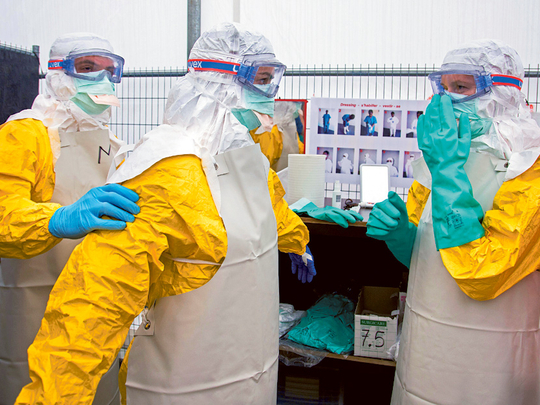
DUBAI: Ebola hysteria has swept across world headlines at a much more alarming rate than the actual virus, but far more widespread killers, diseases such as influenza, tuberculosis and malaria are deprived of such attention, awareness and the fund-raising the goes with it.
The virus, which is thought to have originated from migrating fruit bats, has fuelled anxiety in many countries around the world, but when compared to other recent epidemics in terms of actual reported cases and death its severity is not nearly as widespread.
In 2012, malaria caused an estimated 627,000 deaths, most deaths are African children, and one dies every minute from the disease. Through a combination of mosquito nets and medication it is entirely treatable, but there is very little in the way of worldwide concern at its spread, and no media speculation about which country it might move onto next.
In the same year, 1.3 million people died from tuberculosis. TB, as it’s known, is extremely infectious but again entirely treatable. The World Health Organisation (WHO) estimates that since 1995 more than 56 million people have been successfully treated for the disease.
The most widespread disease, influenza, is described as something which can affect people of any age or social group. Across the globe its annual epidemics result in about 250 000 to 500,000 deaths. And although awareness of the condition is high, it doesn’t receive attention anywhere near the level that Ebola is currently being given.
WHO were also forced to clarify last week that the deaths of 70 people in the north of the Democratic Republic of Congo were due to haemorrhagic gastroenteritis and not Ebola in order to extinguish fears that the outbreak had spread further still.
While the 1,200 confirmed deaths are an undeniable tragedy for those affected, WHO last week released a statement stating that “it doesn’t consider air transport hubs at high risk for further spread of Ebola” and that “it can only be transmitted by direct contact with the body fluids of a person who is sick with the disease”, playing down the disease’s level of contagion as governments dash to quarantine suspected patients and close border crossings.
A cholera outbreak has also killed at least 65 people and infected as many as 1,300 people in northern Cameroon. This outbreak is another described has having had attention and resources deflected from it as a result of the focus on Ebola, which the world bank pledged $200 million to fight earlier this month.
It is possible that the fear around Ebola stems from the difficulty in fighting it. There is neither a cure nor a vaccine, hence the use of experimental drugs. It’s also the most significant outbreak of the condition in recorded history. Ebola outbreaks are nothing new — Congo was hit by one in 2007 and Uganda in 2000 — but the current situation in West Africa dwarfs the next largest outbreak, which took place in Congo in 1976. 280 were killed — a third of the number of victims compared the current outbreak.
— The writer is an intern with Gulf News












